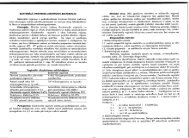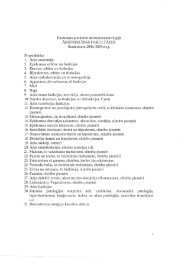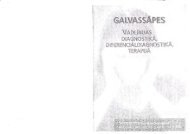PHYSICS
n - susliks.lv
n - susliks.lv
- No tags were found...
You also want an ePaper? Increase the reach of your titles
YUMPU automatically turns print PDFs into web optimized ePapers that Google loves.
-------··CU<br />
~ ..19· ~~<br />
.0 '\<br />
! Spores Growth \<br />
Fig. 7.4. Formation of colony by the<br />
amoebae Dictyostelium discoidem<br />
.. '\l+;/ spores which are separating<br />
Yr·"<br />
~ Plasmodium ----.. 17. +'- from it into the medium. When<br />
~.. Cell they encounter a nutrient rich<br />
~ . agregation environment, they form a new<br />
colony by way of chemotactic<br />
M::;iO:/ migration (fig. 7.4).<br />
7.3. ACOUSTIC WAVES<br />
7.3.1. Classification of Acoustic Waves<br />
A longitudinal wave that consists of a sequence of pressure<br />
pulses or an elastic displacement of the material, whether gas,<br />
liquid, or solid, is called an acoustic wave. There are three<br />
categories of acoustic waves that cover different ranges of<br />
frequency - sound, ultrasound, and infrasound waves.<br />
7.3.2. Physical Characteristics of Sound Waves<br />
Sound has three physical quannties: frequency (Q), intensity<br />
(I), and waveform which correspond to the characteristics of<br />
sound that we hear - pitch, loudness, and tone quality. Sound<br />
waves that lie within the range of sensitivity of the human ear are<br />
called audible sound waves; these waves have a frequency ranging<br />
between approximately 20 Hz to 20000 Hz.<br />
The pitch of a note is determined by the frequency; the more<br />
vibrations per second of the sound, the higher will be the pitch<br />
of the note.<br />
The intensity or loudness of a sound is a measure of the energy<br />
impinging on a unit area of receiver surface per unit of time. The<br />
units of intensity are therefore W/m 2 • The intensity of the faintest<br />
sound which can just be heard is about 10- 12 W/m2; the loudest<br />
66<br />
tolerable sound has an intensity of approximately 1 W1m 2 •<br />
Because of this wide range in intensities over which the ear operates,<br />
and because the ear can only discriminate between sounds<br />
of a certain intensity ratio whether they are loud or soft, a logarithmic<br />
rather than a linear intensity scale is used. The intensity<br />
level (B) of a sound wave is defined by the equation:<br />
I<br />
B = 19<br />
1 0<br />
(7.15)<br />
where 1 0<br />
is an arbitrary reference intensity and is conventionally<br />
taken as the threshold for hearing (i.e., 10- 12 W1m 2 ) . The intensity<br />
7.1. Typical values ofthe sound level is a dimensionless<br />
. levels from various sources quantity and the unit is<br />
or causing specific symptoms the bel (B) or more<br />
commonly, the decibel<br />
Source of Sound ] Sound Level,dBJ (dB).<br />
Damage of eardrum 160<br />
Nearby jet airplane<br />
Threshold of pain<br />
Rock concert<br />
Subway<br />
150<br />
130<br />
120<br />
100<br />
I<br />
dB=10Ig<br />
1 0<br />
Table 7.1 gives<br />
(7.16)<br />
some<br />
Busy traffic 80 typical values for the<br />
Vacuum cleaner 70 sound levels from various<br />
Normal conversation 50 sources or causing spe<br />
Mosquito buzzling 40 cific symptoms in hu<br />
Rustling leaves 10 mans.<br />
Example. The intensity of an ultrasound pulse produced by a bat<br />
during echolocation is about 10- 2 W1m 2 • Express this in decibels.<br />
Solution. Using Equation (7.16), we shall find:<br />
I 10- 2<br />
dB = 10 Ig/ = 10 Ig 10- 12<br />
= 10,10 = 100 dB<br />
o<br />
Tone quality corresponds to the complexity of the frequency<br />
composition of the sound produced by the source. A precision<br />
tuning fork will vibrate with only one frequency, producing a pure<br />
tone. However, most vibrating bodies, in addition to the fundamental<br />
or lowest frequency, have harmonics which are frequencies<br />
that are single multi plies of the fundamentals. If f is the<br />
fundamental frequency, then 2f is calIed the second harmonic. The<br />
67






